Abstract
A mathematical model based on the diffusion-convection equations is used to describe the rheological properties of dilute polymer solutions. The model uses a second-order conformation tensor as a measure of the internal strain; this avoids the mathematical complexity resulting from the use of a more detailed description of the macromolecules and also avoids the necessity of introducing additional ad-hoc assumptions (closure approximations) commonly used in other molecular theories. The rheological equation is obtained in terms of the rate-of-deformation tensor\(\dot \gamma \) and a scalar functionf(σ) relating the extra stress tensorσ to the internal strain tensorc. The functionf(σ) depends on the physical insight introduced in the Helmholtz free energyA(c) of the solvent-polymer system.
This approach is illustrated for an intra-molecular potential of a “FENE-charged” type. The concept of an isotropic, but conformation-dependent, friction coefficient, is also introduced to account for the “coil-stretch” transformation of macromolecules in solution. Viscosity and first normal-stress data, of partially hydrolyzed polyacrylamide solutions, (polyelectrolytes) are analyzed and compared to the model predictions in steady shear and elongational flows.
Similar content being viewed by others
Abbreviations
- a 1,a 2,a 3 :
-
coefficients of eq. (22), eqs. (23b) and (c)
- A(c) :
-
Helmholtz free energy function, eq. (19)
- b :
-
extensibility parameter, eq. (23e)
- c :
-
polymer concentration
- c :
-
intramolecular strain or conformation tensor
- e :
-
electrostatic parameter, eq. (23f)
- E :
-
electrostatic constant, eq. (17)
- f(σ):
-
scalar function defined in eq. (3)
- G :
-
slip parameter
- H :
-
connector modulus
- I c :
-
1st invariant ofc, = trc
- II c :
-
2nd invariant ofc, = trc · c
- III c :
-
3rd invariant ofc, detc
- k :
-
Boltzmann constant
- M :
-
molecular weight
- M W :
-
weight-average molecular weight
- n :
-
number density of macromolecules
- r :
-
position vector
- R :
-
gas constant
- R 0 :
-
maximum extension of the connector
- R :
-
vector connecting two beads
- S(c) :
-
entropy functional, eq. (18)
- t :
-
time
- T :
-
temperature
- U(c) :
-
intramolecular potential, eq. (15)
- U c (c):
-
Coulombic contribution toU(c), eq. (17)
- U FENE(c):
-
FENE contribution toU (c), eq. (16)
- V :
-
velocity vector
- V i :
-
i th component ofV
- Z(θ) :
-
scalar function defined by eq. (29)
- β :
-
friction parameter, eq. (33)
- δ :
-
unit tensor
- \(\dot \varepsilon \) :
-
elongational rate
- ϕ :
-
dimensionless shear stress
- \(\dot \varepsilon \) :
-
shear rate
- \(\dot \gamma _C \) :
-
critical shear rate
- \(\dot \gamma \) :
-
rate-of-deformation tensor
- η :
-
shear viscosity
- η e :
-
elongational viscosity
- η s :
-
solvent viscosity
- η 0 :
-
zero-shear viscosity
- η e0 :
-
zero-elongation viscosity
- η e∞ :
-
high-elongational-rate viscosity
- [η]0 :
-
zero-shear intrinsic viscosity
- ψ(r, R,t):
-
configuration-space distribution function
- ψ 1 :
-
1st normal-stress coefficient
- ψ 2 :
-
2nd normal-stress coefficient
- Λ :
-
dimensionless elongational stress, eq. (45)
- λ e :
-
time constant for very dilute solutions, eq. (48)
- λ E :
-
time constant for non-dilute solutions, eq. (50)
- λ H :
-
time constant, eq. (32)
- ξ :
-
reduced molecular extension, eq. (23 a)
- ξ E :
-
reduced molecular extension at equilibrium, eq. (47)
- σ :
-
extra-stress tensor
- σ ij :
-
components of the extra-stress tensor
- θ :
-
dimensionless 1. invariant of σ, eq. (23 d)
- ζ (c):
-
variable friction coefficient, eq. (33)
- ζ 0 :
-
isotropic friction coefficient
- ∇v :
-
velocity gradient tensor
- ∇v ⊤ :
-
transpose of ∇v
- \(\mathfrak{D}/\mathfrak{D}t\) :
-
upper-convected derivative (Oldroyd derivative)
- D/Dt :
-
substantial derivative
References
Ait-Kadi A, Carreau PJ, Chauveteau G (1987) J Rheology 31:537
Dunlap PN, Leal LG (1984) Rheol Acta 23:238
Bird RB, Dotson PJ, Johnson NL (1980) J Non-Newtonian Fluid Mech 7:213
de Gennes PG (1974) J Chem Phys 60:5030
Hinch EJ (1974) Colloques Internationaux du CNRS, No 233, p 241
Tanner RI (1975) Trans Soc Rheol 19:557
Grmela M (1986) Physica-D, 21D:179
Larson RG (1983) J Non-Newtonian Fluid Mech 13:279
Fuller CG, Leal LG (1980) Rheol Acta 19:580
Bird RB, Hassager O, Armstrong RC, Curtiss CF (1977) “Dynamics of Polymeric Liquids”, Vol 2, Kinetic Theory, John Wiley and Sons, New York
Giesekus H (1982) J Non-Newtonian Fluid Mech 11:69
Ait-Kadi A (1985) Ph.D thesis, Ecole Polytechnique of Montreal
Olbricht WL, Rallison JM, Leal LG (1982) J Non-Newtonian Fluid Mech 10:291
Grmela M, Carreau PJ (1987) J Non-Newtonian Fluid Mech 23:271
Grmela M, Chhon Ly (1987) Phys Lett A 120:281
Carreau PJ, Grmela M (1986) “Modelling of the Rheological Behaviour of Polymeric Liquids” in: DeKee D, Kaloni PN (eds.) “Recent Advances in Structured Continua”, Pitman Publishing Company, chap. 4, p 105
Morawetz H (1961) “Macromolecules in Solution”, Interscience Publishers, John Wiley and Sons, New York
Fan Xi-Jun, Bird RB, Renardy M (1985) J Non-Newtonian Fluid Mech 18:255
Phan-Thien N, Manero O, Leal LG (1984) Rheol Acta 23:151
Miles MJ, Tanaka K, Keller A (1983) Polymer 24:1081, as cited in [2]
Tsai CF, Darby R (1978) J Rheology 22:219
Choplin L (1980) Ph.D thesis, Ecole Polytechnique of Montreal
Chang HF, Darby R (1983) J Rheology 27:77
Leonov AI (1976) Rheol Acta 15:85
Author information
Authors and Affiliations
Rights and permissions
About this article
Cite this article
Ait-Kadi, A., Grmela, M. & Carreau, P.J. A rheological equation of state for dilute polymer solutions with applications to polyelectrolytes. Rheol Acta 27, 241–254 (1988). https://doi.org/10.1007/BF01329740
Received:
Issue Date:
DOI: https://doi.org/10.1007/BF01329740




